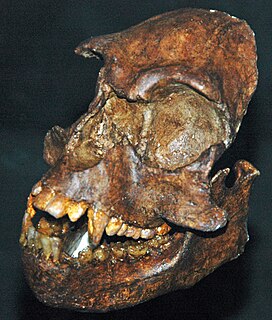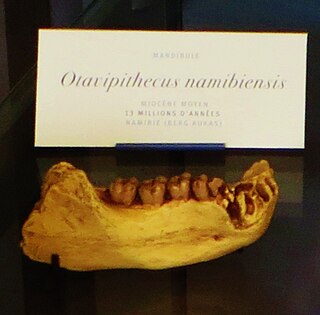
Chevrotains, or mouse-deer, are small even-toed ungulates that make up the family Tragulidae, the only extant members of the infraorder Tragulina. The 10 extant species are placed in three genera, but several species also are known only from fossils. The extant species are found in forests in South and Southeast Asia, with a single species, the water chevrotain, in the rainforests of Central and West Africa. They are solitary or live in pairs, and feed almost exclusively on plant material. Chevrotains are the smallest hoofed mammals in the world. The Asian species weigh between 0.7 and 8.0 kg, while the African chevrotain is considerably larger at 7–16 kg (15–35 lb). With an average length of 45 cm (18 in) and an average height of 30 cm (12 in), the Java mouse-deer is the smallest extant (living) ungulate or hoofed mammal, as well as the smallest extant even-toed ungulate.

Pliopithecus is a genus of extinct primates of the Miocene. It was discovered in 1837 by Édouard Lartet (1801–1871) in France, with fossils subsequently discovered in Switzerland, Slovakia and Spain.

Ouranopithecus is a genus of extinct Eurasian great ape represented by two species, Ouranopithecus macedoniensis, a late Miocene hominoid from Greece and Ouranopithecus turkae, also from the late Miocene of Turkey.

Rusinga Island, with an elongated shape approximately 10 miles (16 km) from end to end and 3 miles (5 km) at its widest point, lies in the eastern part of Lake Victoria at the mouth of the Winam Gulf. Part of Kenya, it is linked to Mbita Point on the mainland by a causeway.

Cycloderma is a genus of softshell turtles in the subfamily Cyclanorbinae of the family Trionychidae. The genus is endemic to Africa.

Nakalipithecus nakayamai is an extinct species of great ape from Nakali, Kenya, from about 9.9–9.8 million years ago during the Late Miocene. It is known from a right jawbone with 3 molars and from 11 isolated teeth, and the specimen is presumed female as the teeth are similar in size to those of female gorillas and orangutans. Compared to other great apes, the canines are short, the enamel is thin, and the molars are flatter. Nakalipithecus is one of only three Late Miocene great apes known from Africa, the others being Samburupithecus and Chororapithecus. Nakalipithecus seems to have inhabited a sclerophyllous woodland environment.
Maboko Island is a small island lying in the Winam Gulf of Lake Victoria, in Nyanza Province of western Kenya. It is about 1.8 km long by 1 km wide. It is an important Middle Miocene paleontological site with fossiliferous deposits that were discovered in the 1930s. The age of the deposits is estimated to be 15 to 16 million years, and they are especially important for the abundance of primate fossils they contain.
Simiolus is an extinct genus of dendropithecid primates. It was described by Mary Leakey and Richard Leakey in 1987, and the type species is S. enjiessi, which existed during the Miocene of Kenya. The species epithet is a phonetic pun on the acronym NGS. A new species, S. andrewsi, also from the middle Miocene of Kenya, was described by Terry Harrison in 2010. In November 2018, scientists reported the discovery of the smallest known ape, Simiolus minutus, which weighed approximately eight pounds, and lived about 12.5 million years ago in Kenya in East Africa.
Ugandapithecus is a disputed extinct genus of hominoid primates that existed from 22 to 14 million years ago during the Miocene epoch. Fossil remains are present in Eastern Africa including Kenya and Uganda. Four species have been classified to date. It has been suggested that these successively larger species evolved from one another. Others argue that Ugandapithecus is a subjective synonym of Proconsul.

Ekembo is an early ape (hominoid) genus found in 17- to 20-million-year-old sediments from the Miocene epoch. Specimens have been found at sites around the ancient Kisingiri volcano in Kenya on Rusinga Island and Mfangano Island in Lake Victoria. The name Ekembo is Suba for "ape" or "monkey".

Pliopithecoidea is an extinct superfamily of catarrhine primates that inhabited Asia and Europe during the Miocene. Although they were once a widespread and diverse group of primates, the pliopithecoids have no living descendants.
Dionysopithecidae is an extinct family of fossil catarrhines and the earliest-known and most primitive members of the Pliopithecoidea superfamily, with fossils in Sihong in China dating to 18–17 million years ago for species Dionysopithecus shuangouensis and Platodontopithecus jianghuaiensis.
Propliopithecoidea is a superfamily of catarrhine primates that inhabited Africa and Arabia during the Early Oligocene about 32 to 29 million years ago. Fossils have been found in Egypt, Oman and Angola. They are one of the earliest known families of catarrhines.
The family Dendropithecidae is an extinct family of catarrhine monkeys. They date from the Early Miocene, around 20 - 12 million years ago.
Propotto is an extinct, monotypic genus of early strepsirrhine primate from the early Miocene of Kenya. It contains one described species, Propotto leakeyi. Although long considered a pteropodid fruit-eating bat after spending a brief sojourn as a prehistoric relative of lorises, recent research shows it to be an extinct relative of the aye-aye.

Otavipithecus namibiensis is an extinct species of ape from the Miocene of Namibia. The fossils were discovered at the Berg Aukas mines in the foothills of the Otavi mountains, hence the generic name. The species was described in 1992 by Glenn Conroy and colleagues, and was at the time the only non-hominin fossil ape known from southern Africa. The fossils consist of part of the lower jawbone with molars, a partial frontal bone, a heavily damaged ulna, one vertebra and a partial finger bone.
The Nyanzapithecinae or Nyanzapithecines are a subfamily of extinct Dendropithecidae as sister of Simiolus. The group contains Rangwapithecus, Turkanapithecus, Rukwapithecus, Oreopithecus, and Nyanzapithecus. In the following tree the internal structure of Nyanzapithecinae of Nengo et al. is followed.
Micropithecus is an extinct genus of primates that lived in East Africa about 19 to 15 million years ago, during the early Miocene. The genus and its type species, Micropithecus clarki, were first scientifically described in 1978.
Nyanzapithecus pickfordi was a species of primate from the Middle Miocene of Maboko Island, Nyanza Province, Kenya. It had an average body mass of around 10 kg (22 lb).










